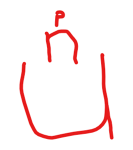View attachment 3175
I'm a visual person, so I've drawn this down
real big on my scratch paper to get it in my head to help me remember p < n < u. Specifically:
1000 pF = 1nF
1000nF = 1uF
@Nostradoomus and
@DGWVI are all over it. To repeat: 1 uF nonpolarized caps do come up every once in a while (...CDXL Reissue Envelop Filter, whoops!). Do take note of the shapes/spacing for those ~1uF caps.
I just wrote this up on reddit a couple weeks ago when someone else asked a similar question. So, I thought to paste it below if you want a few more explicit details (Not to out-do the pros who already weighed in.

From one noob to another, cheers!)
//
In general, these the guidelines below are what I've used. Worked for me when building my PedalPCB projects.
I really liked the "intro" pages over at tagboard effects. Check it out.
uF = Aluminum Electrolytic / Tantalum - These are the
polarized ones. I've used electrolytics for the round, polarized capacitor, tantalums last longer though. Easy way to find them is they usually are listed in the uF range on these build docs. Make sure they are rated for over 16V, you can find most around 50V. When you start get
nF = Mylar film / Polyester Boxes - Nonpolarized. You can get a little creative with the box capacitors, but like others have said - be careful of them getting too big. I got a pack of 100 nF mylar film "greenies", just to play around with them and see if they could fit... and they're huge compared to the standard sized polyester boxes. In general, the smaller nF "greenies" will fit, just be wary of going past 50 nF or so. Make sure they are rated over 16V. I've had some creative soldering jobs with big greenies...
pF = Monolithic ceremic - Nonpolarized. These tiny yellow capacitors are good for the pF caps that you'll come across. Again, make sure they are rated over 16V. All of them over at Tayda are 50V.
Lastly - read up this guideline that
@Jovi Bon Kenobi made, it's really helpful for a first time builder:
"How to build a PedalPCB pedal"



